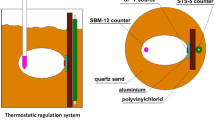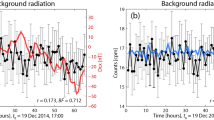Abstract
LAST year several articles were published describing measurements made with the intention of deciding whether the outburst of the Nova Herculis had an influence upon the intensity of cosmic radiation. The results obtained with the coincidence method are not in perfect agreement with each other: Kolhörster1 has found, and we2 have not found, a Nova effect. To clear up the question we made, from July 24 until August 5, 1935, measurements with two Geiger-Müller counters of 100 cm. effective length, and 4 cm. diameter, placed 7 cm. apart with their axes parallel to the north-south direction, one above the other. We used the Barnóthy coincidence method which makes it possible to neglect the number of chance coincidences, as they are less than 0.4 per cent of the true ones. The apparatus is provided with an automatic impulse size regulator which kept the sensibility of the counters during the whole time of measurements at a constant value, so that they were not influenced by any changes occurring in the inside temperature or in the supplying voltage. In 349 hours we registered 1.53 million coincidences; their distribution during the three periods of the day is shown in the accompanying table.
This is a preview of subscription content, access via your institution
Access options
Subscribe to this journal
Receive 51 print issues and online access
$199.00 per year
only $3.90 per issue
Buy this article
- Purchase on Springer Link
- Instant access to full article PDF
Prices may be subject to local taxes which are calculated during checkout
Similar content being viewed by others
References
W. Kolhörster, Z. Phys, 93, 429; 1935.
J. Barnóthy and M. Forró, NATURE, 135, 618; 1935.
J. Barnóthy and M. Forró, Z. Phys., 94, 773; 1935.
The magnetic data were taken from Landolt-Börnstein Erg. Bd. 3; they represent the mean values of the intensity for July and August in the period 1921–1930.
Author information
Authors and Affiliations
Rights and permissions
About this article
Cite this article
BARNÓTHY, J., FORRÓ, M. Diurnal Variation of Cosmic Ray Intensity and Nova Herculis. Nature 136, 680–681 (1935). https://doi.org/10.1038/136680b0
Issue Date:
DOI: https://doi.org/10.1038/136680b0
Comments
By submitting a comment you agree to abide by our Terms and Community Guidelines. If you find something abusive or that does not comply with our terms or guidelines please flag it as inappropriate.



